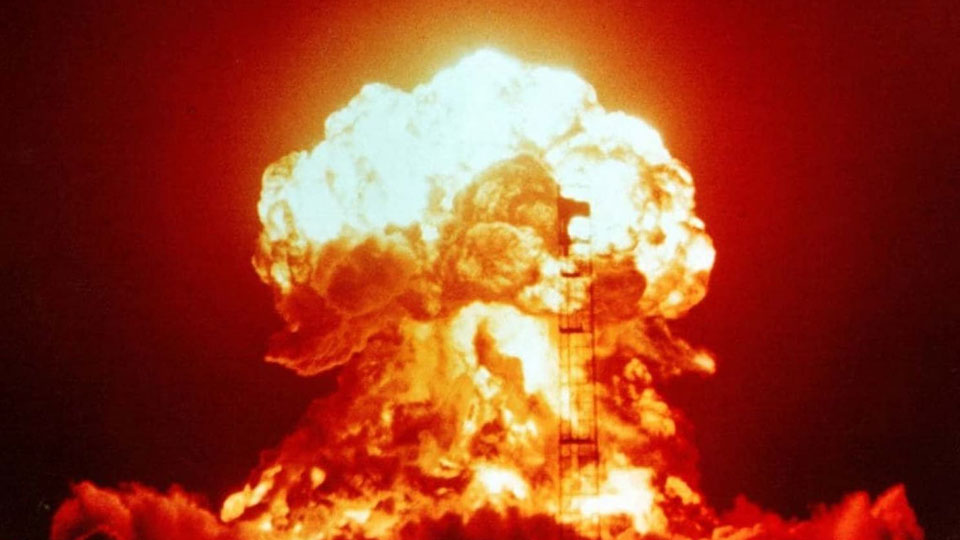Declassified Cold War nuclear plans: U.S. would have blown up half the world
May 30, 201912:56 PM CDT
A nuclear explosion at the Nevada Test Site in 1953. | National Nuclear Security Administration
On August 30, 1945, Major General Lauris Norstad dispatched a document to his superior, General Leslie Groves, outlining a total of 15 “key Soviet cities” to be struck with U.S. atomic weapons, headed by the capital Moscow. This was followed by another 25 “leading Soviet cities” listed for annihilation, topping this latter group was Leningrad, almost destroyed during the Nazi siege finally lifted in late January 1944.
The above nuclear plans were being composed three days before the Second World War had even officially concluded (on September 2, 1945), and a mere two weeks following Japan’s surrender.
These initiatives, targeting the USSR for destruction, were actually developing at least as early as March 1944, at a time when Moscow was a vital wartime ally. Due to ongoing Soviet intelligence reports, Soviet leader Joseph Stalin was privy to America’s nuclear project most certainly by April 1942, but quite likely earlier.
Meanwhile, Japan’s political leaders were compelled to surrender on August 15, 1945, after the U.S. military threatened to drop more atomic weapons over the country. This would have just been feasible, with the Pentagon holding a further two atomic bombs in its stockpile during the latter part of 1945.
In the days stretching beyond late August 1945, Groves’ and Norstad’s schemes of ruin were enlarging. On September 15, 1945, a highly classified document relating to their plan expounded in stark tones that, “The immediate destruction of the enemy’s will [USSR] and capacity to resist is the primary objective of the United States Army Strategic Air Forces,” to be focused upon “the enemy centers of industry, transportation, and population.”
That same day, Groves and Norstad estimated that more than five dozen Soviet metropolises, 66 altogether, should be obliterated with 204 atomic bombs—a “revolutionary” weapon which was “spectacularly successful” in desolating Hiroshima and Nagasaki, Japan. It was calculated that these 66 cities held 100% of the Soviet Union’s aluminum production, 97% of its tanks, 95% of its aircraft, and 95% of its oil refining capacity.
This declassified material—virtually ignored by commercial media and largely avoided by alternative news—is of particular importance, as it blows apart the long-purported myths that the so-called Cold War began in 1947. It further debunks claims that the beginning of hostilities between the U.S. and the USSR was due to Soviet antagonism.
A top-secret Pentagon document, once more dated September 15, 1945, outlined explicitly that, “the destruction of the Russian capability to wage war has therefore been used as a basis upon which to predicate the United States’ atomic bomb requirements.”
Ever eastwards, more than 20 cities in Soviet-occupied Manchuria were also “investigated” for atomic attacks, but it was eventually decided this resource-rich region “is not an integral part of the USSR.”
America’s atomic arsenal unleashed over the Soviet Union would, preferably, be delivered by the upcoming B-36 “Peacemaker” six-engine bomber, with its remarkable 230-foot wingspan—and not, as thought, with the smaller B-29 “Superfortress” aircraft, fresh from discharging two bombs over Japan.
The B-29’s roaming capacity was more than 5,000 miles without refueling, but even this impressive distance had its limitations for what was now envisaged. By comparison, the B-36 boasted a flying range of 10,000 miles.
The B-36 could, in fact, fly from Washington to Moscow, drop its terrible load, and subsequently return to the American capital without having stopped once there or back (combined distance 9,700 miles). This feat would also have been achievable for the B-36 regarding other Soviet cities such as Leningrad, Kiev, Kharkov, and so on. Yet the B-36 would not be available for such operations until finally entering service during mid-1948, and even after that, the aircraft necessitated further adjustment.
Failing the proposed deployment of 204 atomic bombs, a “minimum requirement” of 123 atomic weapons was contemplated, while at the opposite end of the spectrum an “optimum requirement” constituted an eye-watering 466 bombs.
In September 1945 the “minimum requirement” of 123 bombs was not realistic, let alone the 466 figure, and indeed the latter number was then not seriously considered. By June 1948, America’s nuclear cache still consisted of a modest 50 atomic weapons. Moscow was now to be struck with eight bombs, Leningrad with seven.
From mid-1948, America’s atomic numbers ballooned as the age of “nuclear plenty” was born. By the summer of 1949, Washington had the required 200-plus atomic bombs needed to deliver their Soviet apocalypse.
Yet the USSR, recognizing the threat, had feverishly been constructing its own nuclear weapons. Just as the U.S. arsenal was approaching requisite size, in August 1949, the Soviets detonated an atomic device over Semipalatinsk, in north-eastern Kazakhstan.
The USSR’s nuclear explosion, nearly identical to that of the United States’ Nagasaki bomb, was detected within days by the U.S. Air Force. After they cross-checked the Soviets’ atomic debris, President Harry Truman, informed of the news, was appalled.
American intelligence had deduced that the Soviets would likely be unable to acquire atomic bombs until 1953, at the earliest. A CIA memorandum from December 15, 1947 insisted, “It is doubtful that the Russians can produce a bomb before 1953, and almost certain they cannot produce one before 1951.”
In October 1948, General Curtis LeMay, a ruthless war leader, assumed control of U.S. Strategic Air Command, with Groves cast into obscurity early that year. LeMay promptly hammered out an Emergency War Plan, which called upon the USSR’s evisceration with “the entire stockpile of atomic bombs, if made available, in a single massive attack.”
The following year, October 1949, LeMay expanded strategies so as to include the destruction of over 100 Soviet urban regions with 292 atomic bombs. This significant total would not be available until June 1950, by which time the success of the Soviet Union’s nuclear project had been confirmed.
Yet by 1950, the Pentagon was churning out Nagasaki-type bombs on a production line. The Nagasaki weapon, “Fat Man,” had a yield of 21 kilotons, making it considerably more powerful than the Hiroshima device, “Little Boy,” which held 15 kilotons of explosive force.
By New Year’s Day 1951, the Pentagon’s nuclear stash hit 400 bombs, the precise number need for “killing a nation.”
In the 1950s, the program would undergo major enlargement in order to encompass a new target in its crosshairs—China, a country then home to over half a billion people. China, it may be noted, did not develop nuclear weapons until 1964.
At maps in U.S. military headquarters throughout the Pacific region, the USSR and Chinese land areas were laid out as a combined whole: One giant red mass with no defining borders to distinguish between either state. Both were to be decimated together, while suggestions in a bid to change the stratagem were met with firm opposition and “sent shudders down planners’ spines.”
These maps, obscured by a curtain or screen from unassuming visitors, were marked with pins and arrows highlighting which areas were to be flattened with nuclear bombs. By 1960, it was decided that every city in the USSR and China would be attacked with nuclear weapons—hundreds of urban centers. For example, each populated space in the Soviet Union containing 25,000 people or more was earmarked to be struck with a nuclear bomb. These programs would largely be implemented with the new long-range, jet-powered bombers, the B-52 and B-58, with the obsolete B-36 sent into retirement in 1959.
In the early 1960s, this greatly increased level of destruction was possible, as the Pentagon’s nuclear cargo reached about 18,000 bombs. The majority now consisted of infinitely more powerful hydrogen weapons. Moscow was to be hit with a yield of 40 megatons, about 4,000 times more powerful than the Hiroshima bomb.

Moreover, the USSR’s Warsaw Pact allies in central and southern Europe were also designated for annihilation; Czechoslovakia, Hungary, Poland, Romania, Bulgaria, and Albania would all be wiped from the map as well. These nations are today all members of the U.S.-led NATO military alliance, with Czechoslovakia since dissolving into two separate countries, both belonging to NATO.
The U.S. Joint Chiefs of Staff, the military body that advises the president, calculated in 1961 that nuclear attacks against the USSR, China, and Warsaw Pact states would kill around 600 million people. Even this mind-numbing figure was a conservative estimate, which did not fully take into account the aftermath of such intended actions.
The Soviet Union—with its nuclear cache pointed at the U.S.’ NATO allies—would, in response to a U.S. first strike, fire its warheads at NATO states in western Europe, wiping them from the face of the earth.
If there was any lingering doubt as to the outcome, the resulting radioactive fallout from U.S. nuclear assaults on European Russia and Warsaw Pact members was expected to be blown on the wind towards the Atlantic. This would doubly eradicate much of western Europe, such as France, the Netherlands, Belgium, etc. To the north, Finland was thought to be one of the first to face immediate destruction, following close-range fallout from planned nuclear explosions over Leningrad’s submarine pens.
Nor would the devastation from fallout be restricted to Europe, far from it. Further nuclear attacks on the southern and eastern USSR, along with large-scale assaults across China, would thereafter affect many other states in Asia. Radioactive poisoning was anticipated to spread southwards over India, whose population in 1960 comprised 450 million people.
Afghanistan, bordering both the USSR and China, faced extensive ruin from fallout, as did Japan, whose southern reaches are located just a few hundred miles from eastern China. Mongolia, a large Asian country squeezed between the USSR and China, could expect its fair share of radiation.
The combined death toll from all of the above would surely have been closer to one billion. However, unbeknownst to everyone concerned in the early 1960s, due to the extinction phenomenon of nuclear winter, the United States too would have faced its end, even without retaliatory strikes reaching U.S. soil. This doomsday scenario remains entirely relevant today, in our age of nuclear proliferation and environmental decline.




Geen opmerkingen:
Een reactie posten